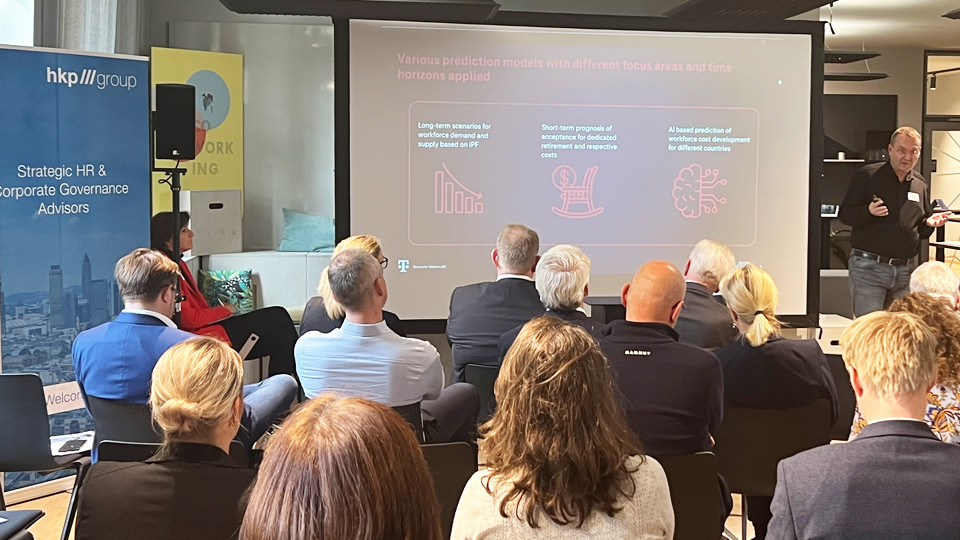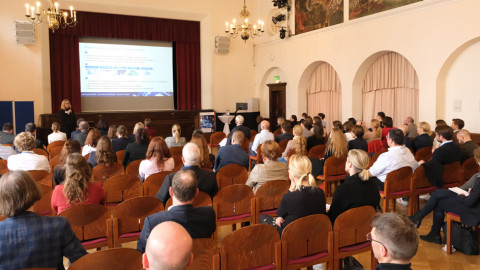On October 18th, 2023 in Munich, professionals from companies and academia discussed the potential of HR analytics with a focus on the workforce of the future and, in particular, the importance of reskilling and upskilling in the corporate context. How can skill requirements be quickly identified, predicted and managed in times of permanent transformation? Under this guiding question, the event built a bridge between science and business in the form of impulses, status reports, best practice presentations and scientific findings. It provided valuable insights into research, highlighted current pain points for companies and presented viable, innovative solutions.
Professor Dr. Florian Englmaier, Professor of Economics and spokesperson for the Predictive People Analytics (PPA) platform at Ludwig-Maximilians-Universität München, welcomed the speakers and guests as patron of the event series organized by hkp/// group, Ifo Institute and LMU/PPA. He and his colleague, Professor Dr. Ingrid Hägele, presented the work of the Predictive People Analytics (PPA) platform. Its aim is to combine science and practice in the field of modern personnel and organizational research. He presented the current event as an ideal example of how PPA shares the findings of leading researchers with practitioners, but also ensures that practical insights are reflected back into research activities - especially as a partner and correspondent for scientific projects with and within companies.
The macroeconomic perspective on the shortage of skilled workers: Prof. Dr. Clemens Fuest, ifo Institute
The President of the ifo Institute, Prof. Dr. Clemens Fuest, offered a macroeconomic analysis where he highlighted the dramatic decline in the available labor pool in the German economy. Due to demographics, increasing part-time employment and trends towards a general reduction in working hours, the labor force will continue to diminish and is unlikely to reach 2020 levels even with high net immigration.
Despite all optimism, these deficits cannot be compensated for by the market alone, i.e. via wage increases and comparable incentives. Apart from the ongoing automation and digitalization of operations within businesses and administration, along with the increased integration of foreign labor, specific incentives and work opportunities are essential. These could include measures like citizen’s income, adjustments in income taxation, or improved childcare provisions. Even approaches that are publicly criticized, such as reducing early retirement in order to extend working life, need to be vigorously implemented.
Finally, there are also training and further education measures that can support companies in addressing the limited availability of workers. However, in order to be able to act with effective solutions, a better basic understanding of the central criteria and key figures of human capital management is required. The cooperation between the ifo Institute, LMU/PPA and hkp/// group is therefore heading in the right direction.
HR analytics in the context of regulation and sustainability: Petra Knab-Hägele, hkp/// group
Petra Knab-Hägele, Senior Partner and Head of Strategic HR Advisory at hkp/// group, believes that the basic understanding of processes and key figures in HR management called for by Prof. Dr. Clemens Fuest will increase, partly due to new regulatory requirements. For example, the European Sustainability Reporting Standards (ESRS) and, in particular, their S1 standard relating to the "own workforce" will require companies at the European level to report key human capital management indicators on an annual basis in future. This necessitates the collection of these key figures, which is a struggle for many organizations. There is often no conceptual framework for the data to be collected in companies and even sub-organizations often work with different key figures or different standards. In addition, there are sometimes fundamentally different technical or technological platforms that support the consistent transparency, availability and quality of the data.
She pointed out that in the context of HR analytics, many companies are not only concerned with the obligation to report, but also with having data available of their own workforce management in a quality and quantity that guides their actions. After all, companies can only act efficiently and effectively as part of their transformation agenda if they know where they are heading and have identified the relevant key figures. This also serves as a prerequisite for a credible narrative when communicating with investors and stakeholders.
Petra Knab-Hägele also referred to a recent short survey conducted by LMU Munich and hkp/// group in the run-up to the event. The analysis suggests that companies see the conceptual and technical effort as well as the involvement of the co-determination side as challenges for HR analytics projects. According to the survey, companies are generally positive about the potential of HR analytics and expect a consistently high level of benefit from it, particularly in quantitative and qualitative personnel planning, in the fulfillment of regulatory reporting obligations and in re-skilling and up-skilling. In particular, in view of the increasing demand for skilled workers, the management consultant considered the ongoing identification of current qualifications and investment in the future skills and knowledge of the workforce to be a key success factor for the long-term successful implementation of business strategies.
Quantitative workforce planning: Kay Nolden, Deutsche Telekom
The broad market overview was followed by specific insights into the HR analytics practices of selected companies. First, Kay Nolden, VP Workforce Planning and Workforce Analytics at Deutsche Telekom AG, presented the status and various measures in the context of quantitative workforce planning. He pointed out that workforce planning is a central component of the Group's integrated planning and management process (iPF), which takes around 30 HR management key performance indicators (KPIs) into account - including headcount, fluctuation and specific costs. The aim is to prevent surprises in the Group's HR development while at the same time create transparency regarding requirements and solutions within the company. Close coordination with the CEO and CFO is an important success factor here.
Long-term scenarios developed specifically for HR planning and short-term developments, such as offers of early retirement or early departure from the company, were also taken into account. AI-based forecasting models for the development of personnel costs for various countries and business areas are also being used for the first time. The aim is to drive this development forward and to integrate HR-driven workforce planning even more closely into strategic Group planning and enable even more reliable long-term forecasts based on a wide range of demand scenarios.
To date, the Strategic Workforce Planning process includes around 130,000 FTEs. Positive effects are already evident. The Group is aware of requirements such as current and future job profiles, and has initiated a learning process within management which has ultimately led to greater visibility and higher appreciation of HR within the company.
A modular approach to group-wide re-skilling and up-skilling: Ann-Kathrin Altendorfer, Siemens
Ann-Kathrin Altendorfer, Project Manager Transformation & Enablement at Siemens AG, presented aspects and solutions in the systematic realization of re-skilling and up-skilling potentials,specifically a conceptual approach or modular construction kit that the Group makes publicly available.
Based on the question of how the company's own workforce can be systematically and specifically prepared for structural change, a project team was formed that first analyzed existing skills for selected job profiles and compared them with target images. Ultimately, around 80,000 employees from more than 30 countries and 95% of job families were included in the NEXTWORK project. The result was a concrete and practicable roadmap using skills profiles for each (new) job profile, which was piloted - also on an international scale - and then scaled across continents.
In contrast to previous approaches to the analysis and realization of re-skilling and up-skilling potential, a number of factors were taken into account. These include the analysis of external trends and strategic business decisions and their impact on employees - both qualitatively and quantitatively. In terms of motivation, specific needs for action were also identified and measures defined. The breakdown of future personnel requirements, e.g. into job profiles, business areas or regions, is also one of the project-specific success factors. Added to this is a flexible and modular methodology that builds on existing structures and is adapted to specific business requirements. Finally, the goal was defined as strengthening organizational adaptability through continuous improvement.
Findings on retraining and qualification: Jorge Tamayo, Harvard Business School
Jorge Tamayo, Assistant Professor of Business Administration in the Strategy Unit at Harvard Business School, provided scientific findings on the re-training and re-skilling of employees in international companies. He presented his leading work from the Digital Reskilling Lab, which launched the task of collecting data and best practices on relevant training and development initiatives in order to identify success factors.
Based on the Digital Reskilling Lab's research, middle and lower management play a crucial role in recognizing individual skill requirements and the need for training and development. It is particularly important for companies to set appropriate incentives for managers in order to promote the further training of employees. Current research findings also show that employees' self-image is an important hurdle, particularly when it comes to re-skilling. If employees do not see themselves in a different position, companies find it difficult to find interested people. At the same time, employees also sign up for training and development opportunities where the need is not or not necessarily given. He identified resolving this two-sided mismatch as a key challenge.
Concluding panel discussion
The concluding panel discussion between the day's speakers, moderated by Dr. Cornelia Geißler, Head of Communications at the ifo Institute, once again highlighted the potential, but also the challenges, in the areas of skills management and HR analytics. Professor Dr. Oliver Falck, Head of the Center for Industrial Economics and New Technologies at the ifo Institute, enriched the exchange by providing current and reliable figures on the actual shortage of skilled workers across sectors and regions.
Overall, the event "Skill Management - Quantitative & Qualitative HR Analytics in Times of Permanent Change" made it clear that modern technology in HR analytics is essential for intelligent workforce planning that does justice to transformational developments. Larger companies in particular are already focusing on this with several internal applications that provide valuable information. However, this process requires a willingness to engage intellectually with the topic, investment - both financially and conceptually - and organizational cooperation. The workforce of the future needs more flexibility in skills management. But above all, it needs digital and methodological skills coupled with high-quality internal data.


